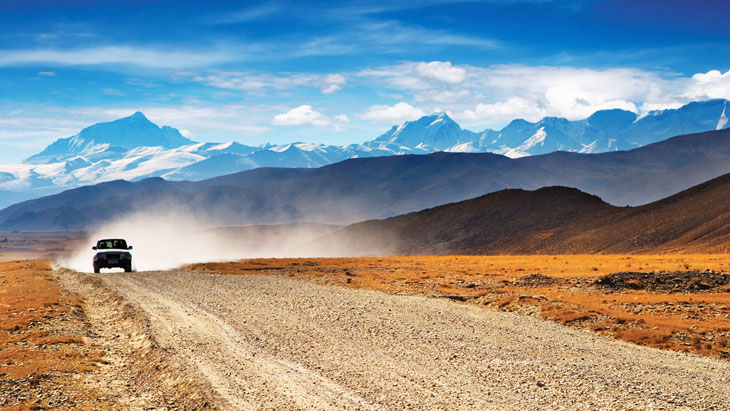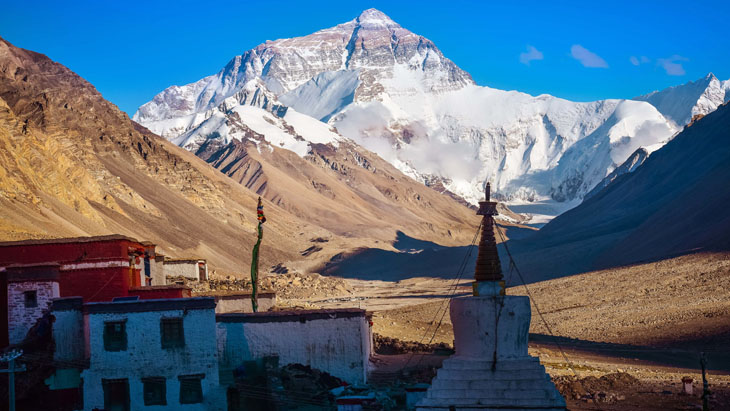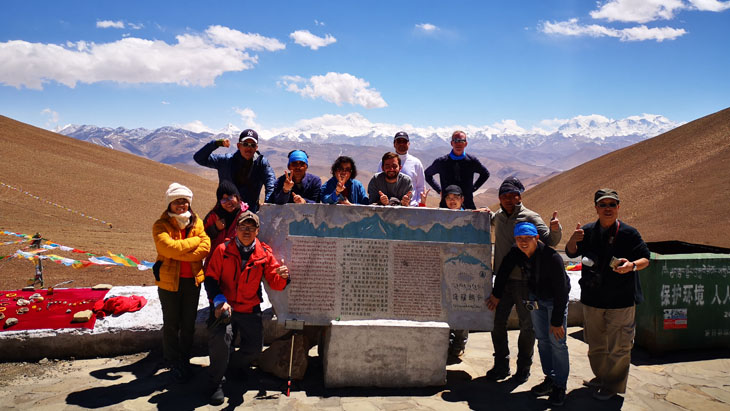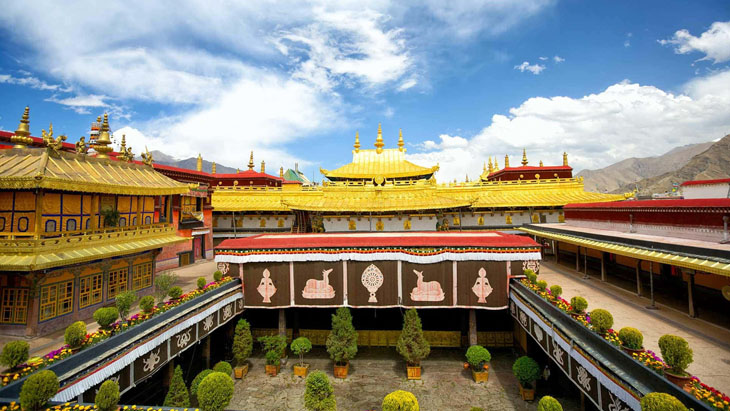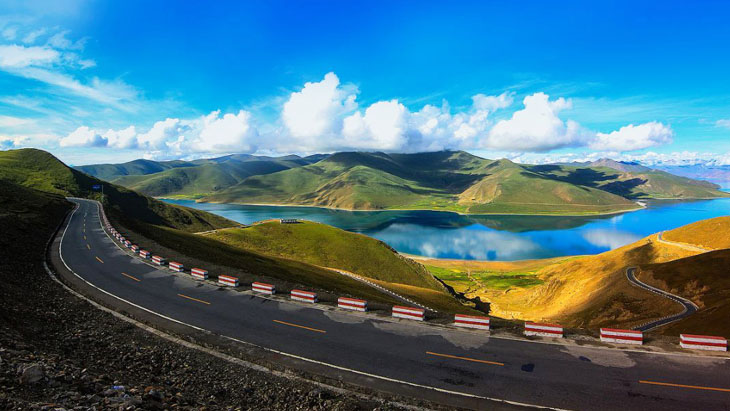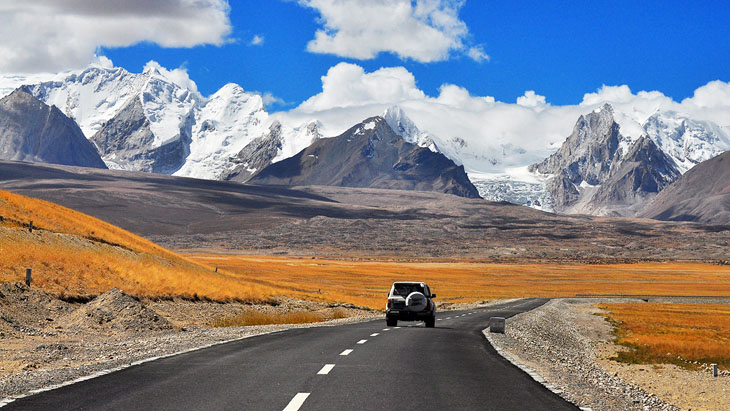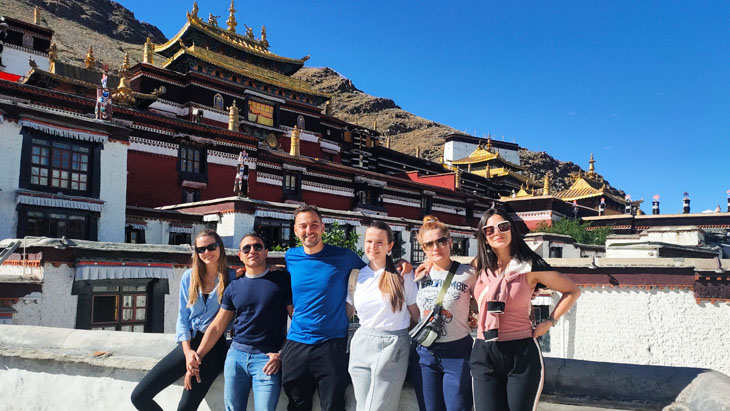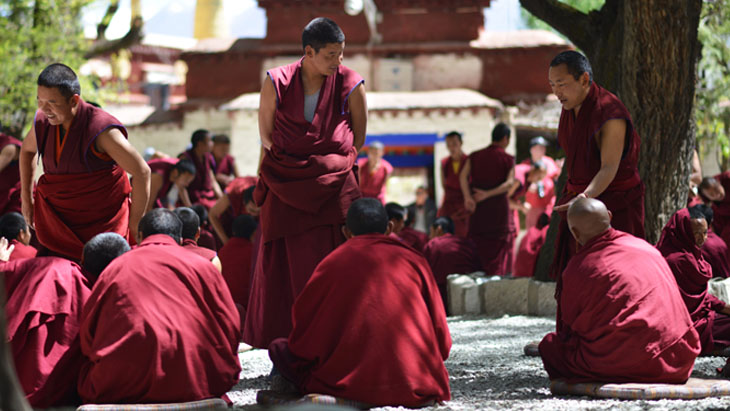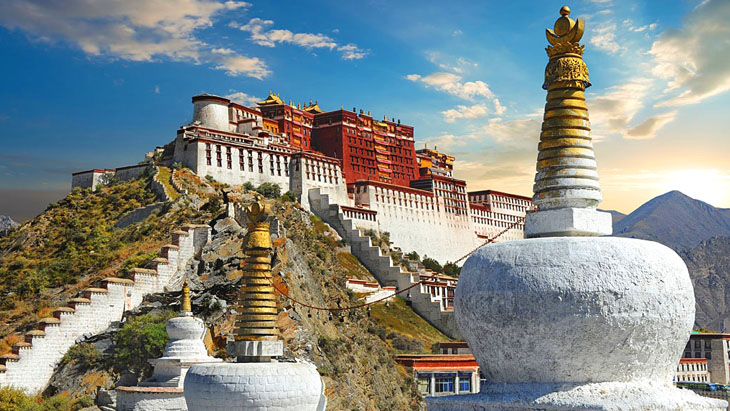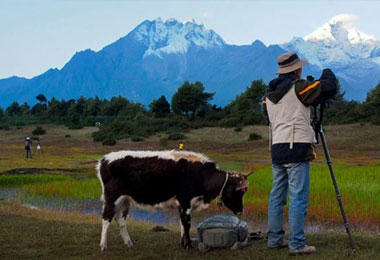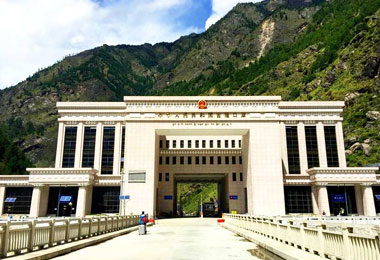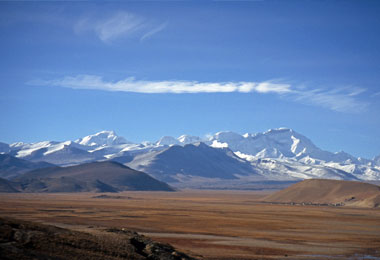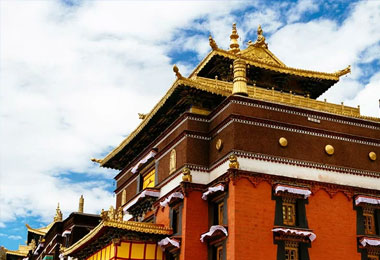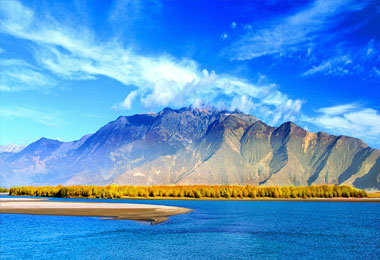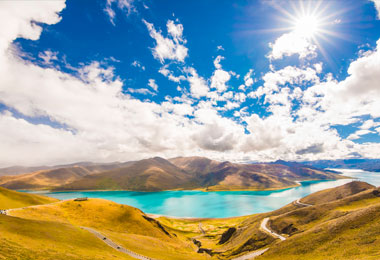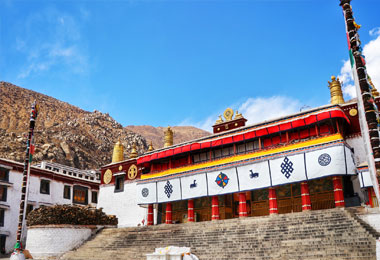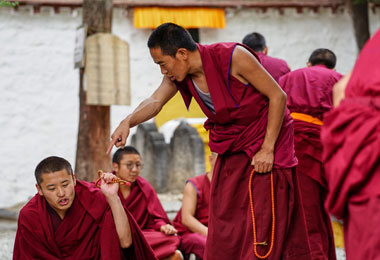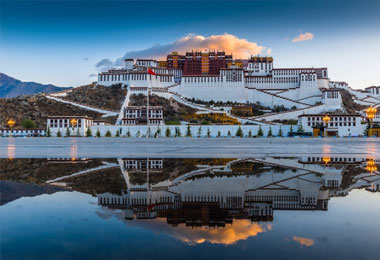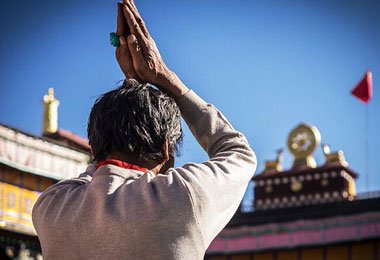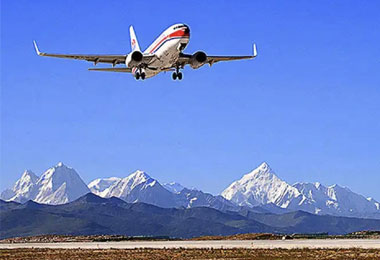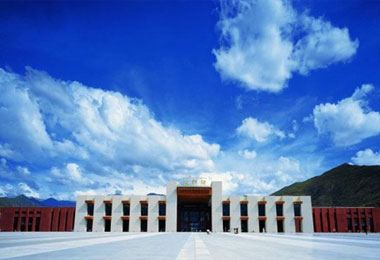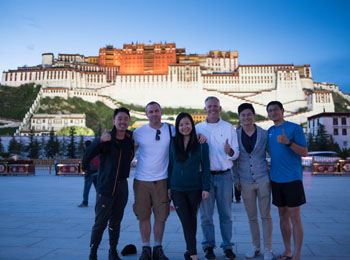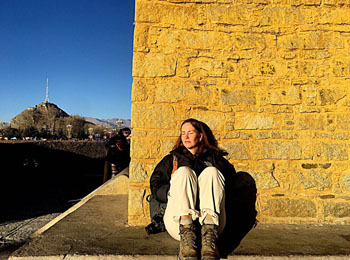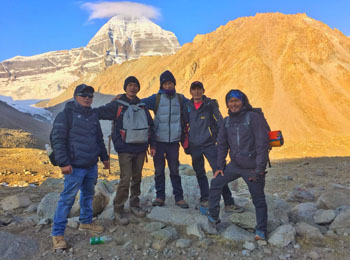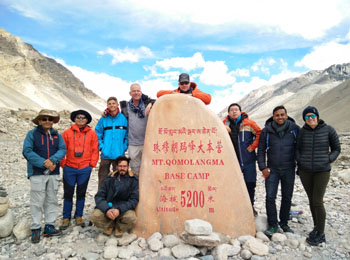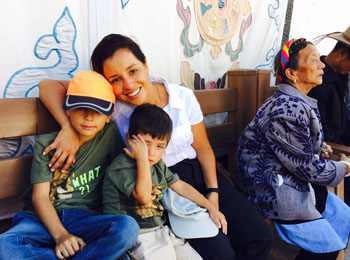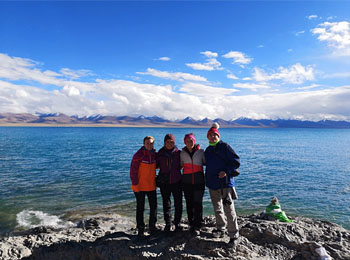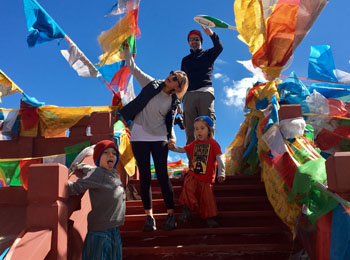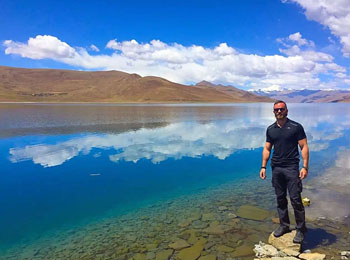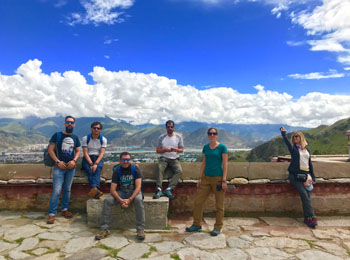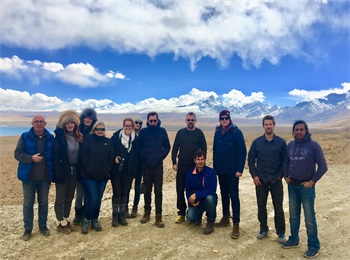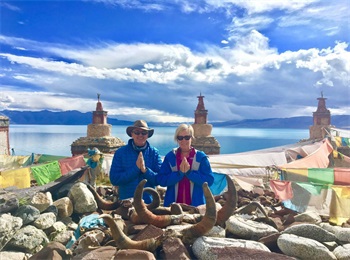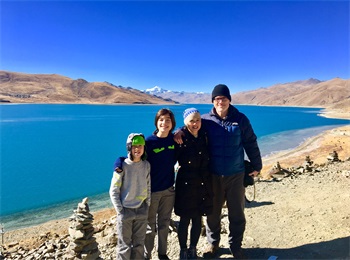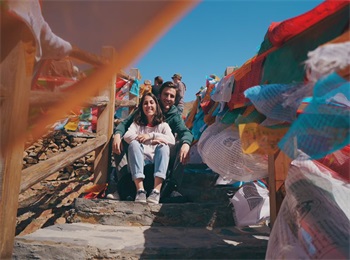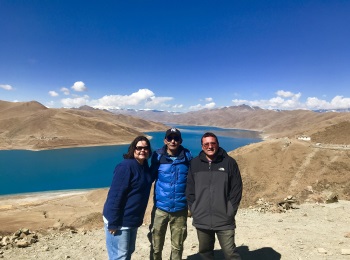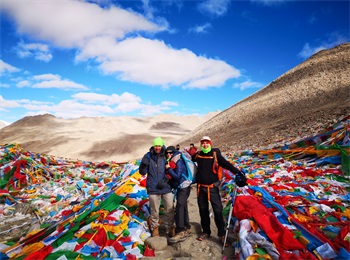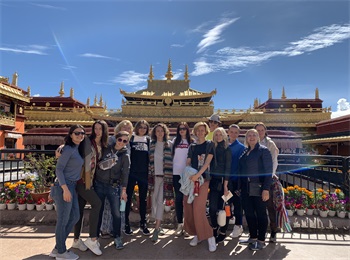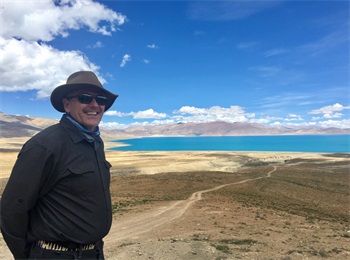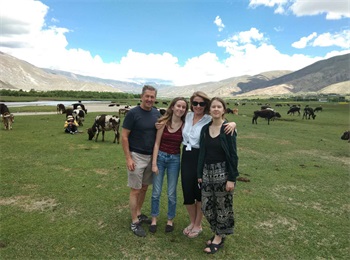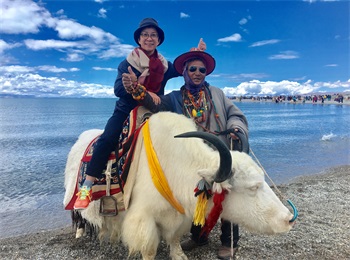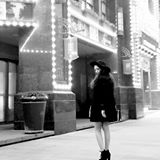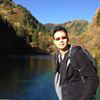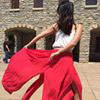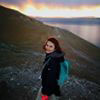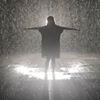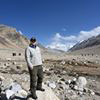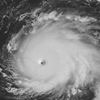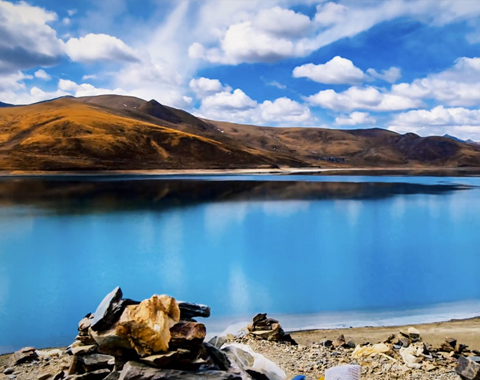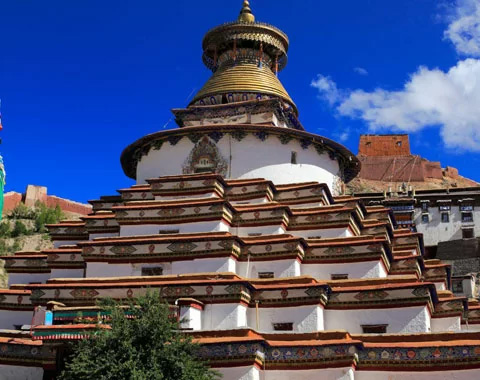8 Days Driving Across Himalaya Overland Adventure from Kathmandu to Lhasa
Tour Route: Kathmandu - Gyirong - Everest Base Camp - Tingri - Shigatse - Gyantse - Lhasa

 Tour Code:
SG007B
Tour Code:
SG007B
 Tour Type:
Join-in Small Group Tour (Min 1 to Around 12) i
Tour Type:
Join-in Small Group Tour (Min 1 to Around 12) i
- Guaranteed Departures: Our tour dates are fixed, ensuring each departure is guaranteed.
- Flexible Scheduling: If you can't find a date that suits your travel plans, no need to worry. Simply let us know your preferred travel time, and we'll create a custom schedule, inviting others to join you.
- Non-shopping Experience: Embrace a non-shopping adventure with us. We promise high-quality tours, ensuring an authentic and enriching experience in Tibet.
 Tour Service:
Tibetan Local Tour Guide & Driver
Tour Service:
Tibetan Local Tour Guide & Driver
 Time to Vist:
Available All Year Around
i
Time to Vist:
Available All Year Around
i
- The epic overland journey from Lhasa to Kathmandu can be done all year round, among which April to May and September to October is the best time to visit.
- The summer months from July to August are peak holiday seasons, but also the rainy season. Pay attention to the land slide at the border.
- Winter, from November to February, is the off-season, making it the best time to travel from Kathmandu to Lhasa on a budget. With less rainfall, it is also ideal for clear views of the Himalayas in winter.
 Trip Level:
Easy Trip for All Ages
i
Trip Level:
Easy Trip for All Ages
i
- This Kathmandu to Lhasa overland tour is suitable for all fitness levels, including families with kids and seniors. The trip takes you from Kathmandu at 1340 meters above sea level to Lhasa at 3650 meters, passing through the Everest Base Camp at 5200 meters. Keep in mind that high altitude sickness may happen. However, we've planned the itinerary carefully and maintained a gradual pace to help you get used to the altitude. If you have any health concerns related to high-altitude sickness, it's advisable to consult your doctor for expert advice.

We provide quality service and wonderful experiences through the Himalayas from Kathmandu and Lhasa.

8 Days from USD1069
- This price is based on double occupancy;
- This price is based on 3-star accommodation level in low season;
- This price doesn’t include the international airfare.
Overview & Highlights of this Trip
There's no more thrilling and adventurous way to enter Tibet than by traveling overland from Kathmandu to Lhasa. Our 8-day overland expedition from Kathmandu takes you through the stunning Great Himalayas, showcasing high peaks, pristine alpine lakes, ancient glaciers, and Buddhist sites all the way to Lhasa, the spiritual heart of Tibet.
Upon entering Tibet, you’ll wander in Gyirong Valley, a secret place known as one of the most beautiful valleys in the world. Along the winding mountain road, you will visit the Everest Base Camp, appreciate the majesty of Mount Everest from three distinct platforms, and marvel at the magic of nature. Then, the visit to Tashilhunpo Monastery will take you to explore the real life of local monks, and a stroll by Yamdrok Lake will bring you a different kind of tranquility. Finally, the journey will lead you to Lhasa, the holy city on the plateau. In Lhasa, you will have the opportunity to visit the ancient Jokhang Temple and the world-famous Potala Palace to experience Tibetan life and beliefs.
For a safer and more enjoyable journey, we've extended the original 7-day tour to 8 days. This includes a day in Gyirong Town (2700m), which reduces the risk of altitude sickness when going from Kathmandu (1400m) to Tingri (4300m).
As the only local Tibet travel agency with offices based in Kathmandu, Lhasa, and Chengdu, our Tibetan and Nepali staff will help you to get the Tibet Permit (for free) and the China Group Visa for Tibet entry from Kathmandu.
Embark on a truly hassle-free overland adventure through the best of the Himalayas, awaiting your discovery.

Highlight 1 of this Trip: Drive overland from Kathmandu to Lhasa and enjoy the beauty of snow-capped mountains on both sides of the Himalayas.

Highlight 2 of this Trip: Admire the beauty of Mount Everest from different viewing platforms.

Highlight 3 of this Trip: Appreciate the tranquil and peaceful Pelku Tso Lake at the foot of Mt. Shishabangma.

Highlight 4 of this Trip: Visit Everest Base Camp at an elevation of 5200m above sea level and witness the summit of the world.

Highlight 5 of this Trip: Admire the Potala Palace, the UNESCO World Heritage Site and the landmark of Lhasa.

Highlight 6 of this Trip: Experience the daily life of local Tibetans in the traditional Tibetan Teahouse.

Highlight 7 of this Trip: Witness Monks debate in Sera Monastery.

Highlight 8 of this Trip: Appreciate the turquoise Yamdrok Lake at different platforms.

Highlight 9 of this Trip: Explore the lives of Tibetan monks and their practices by visiting monasteries with our Tibetan guide.
Itinerary Details
Trip at a Glance
Day 1: Kathmandu - Rasuwa Gadi
Day 2: Rasuwa Gadi - Gyirong
Day 3: Gyirong - EBC - Tingri
Day 4: Tingri - Lhatse - Shigatse
Day 5: Shigatse - Gyantse - Lhasa
Day 6: Lhasa Day Tour
Day 7: Lhasa Day Tour
Day 8: Lhasa Departure
Day 1: Kathmandu to Rasuwa Gadi
Today, you’ll drive to the Sino-Nepal border along the southern side of the Himalayas!
In the morning, we will pick you up at your hotel in Kathmandu and drive to the Sino-Nepal border. After about 7 hours of driving (130km) you will reach the border town - Rasuwa Gadi.
The scenery along the way from Kathmandu to the border will make you almost forget the bumpy road. Along the way, you will see many magnificent snow-capped mountains at the southern foot of the Himalayas, covered by vast forest, towering into the clouds.
When pass through Langtang National Park, you will go through a very bumpy road section, with the vehicle swinging on the muddy road. But the exciting thing is that you may encounter some interesting wild animals on the way.
Upon arrival in Rasuwa Gadi, check in at your hotel and have a good rest.
Stay overnight in Rasuwa Gadi.
Insider Tips:
1. For Chinese Group Visa application, make sure you arrive in Kathmandu in advance and please visit Tibet Vista’s office in Kathmandu at least 4 working days before you go.
2. You need to provide the original passport and pay the visa fee and service fee, so that our staff can apply for the Chinese Group Visa on your behalf.
 Overnight in Rasuwa Gadi
Overnight in Rasuwa GadiDay 2: Rasuwa Gadi to Gyirong (B)
Enjoy a day excursion at Gyirong to acclimatize the altitude rise to 2800 meters above sea level.
After breakfast, you’ll take a 15-km drive to the border and enter China via the Gyirong border. Our Tibetan guide will meet you at Gyirong side and take you to Gyirong town within a 1-hour drive.
Upon arrival, you will explore Gyirong Valley described by British explorer Howard-Bury as the most beautiful valley in the world in his book 'Mount Everest: The Reconnaissance'.
Here, you can visit the Sherpa villages and admire dense forests, serene villages, and beautiful snow peaks above the woods.
Stay overnight in Gyirong.
 Overnight in Gyirong
Overnight in Gyirong Breakfast
BreakfastDay 3: Gyirong to Everest Base Camp to Tingri (B)
Today, you’ll head from the border to Everest Base Camp and enjoy the wonderful changes of landscapes from 2800 meters to 5200 meters above sea level.
After breakfast, you will leave Gyirong, which is densely covered with forests and snow-capped mountains, and officially head to Mount Everest region with an altitude of more than 4500 meters.
On this 380-kilometer journey, you will see the scenery along the road changing as the altitude increases.
First, you will be attracted by the forests, waterfalls, and bottomless canyons at an altitude of 2800 meters. Then cross the Kong Tang Lamu Pass at an altitude of 5236 meters and enter the plateau.
When passing by Mt. Shishabangma (8027m) and Pelku Tso Lake at its foot, you will be shocked by the tranquil and peaceful beauty.
After that, you will enter the Mount Everest area. When passing through the world's most beautiful Everest viewing platform - Gawula Pass (5198m), you will see five peaks above 8000 meters in the Himalayas lined up. The world-famous Mount Everest stands among them, and beneath the peaks is the churning sea of clouds.
Later, you will arrive at Everest Base Camp (5200m), which is the second observation deck of Mount Everest. Here, you'll admire the world's highest peak from the foot of Mount Everest's North Slope and visit the world's highest temple, Rongbuk Monastery (5154m).
After visiting Everest Base Camp, we will continue our journey to Tingri (4300m).
Stay overnight in Tingri.
Insider Tips:
Since today’s itinerary rises sharply from low altitude to over 5000 meters, in order to ensure your travel safety and avoid altitude sickness, we choose to spend the night in Tingri County (4300m) instead of Everest Base Camp (5200m).
 Overnight in Tingri
Overnight in Tingri Breakfast
BreakfastDay 4: Tingri to Shigatse via Lhatse (B)
The highlight of today’s journey is to visit the home of Panchen Lama - the Tashilhunpo Monastery in Shigatse.
Start the journey to Shigatse in the morning, you will first visit the 5000m G318 National Highway milestone in Lhatse on the way.
After your arrival in Shigatse in the early afternoon, you will visit the seat of Panchen Lama - Tashilhunpo Monastery, one of the most important monasteries in Tibet. The grand and magnificent halls of the largest local monastery occupy the entire hillside. This is the spiritual home of the Tibetan people in Shigatse, housing the world's largest statue of Maitreya Buddha.
Stay overnight in Shigatse (3900m).
 Overnight in Shigatse
Overnight in Shigatse Breakfast
BreakfastDay 5: Shigatse to Lhasa via Gyantse (B, L)
Today, you’ll visit the ancient Gyantse Town and the sacred lake Yamdrok Yumco, and enjoy a wonderful lunch at a lakeside farmhouse.
In the morning, start the overland journey from Shigatse to Lhasa, which includes visits to Tibet's most beautiful lake, glacier, and a charming Tibetan village.
After arriving in Gyantse, you can spend some time taking photos of the ancient city of Gyantse and visit the Perklor Monastery and Kumbum stupa.
Next, you will pass and enjoy the Korola Glacier on the roadside. It is the largest glacier in Tibet. As you see the ice tongue of the glacier climb the entire hillside, you will feel the magical power of nature.
After that, drive to Yamdrok Lake, one of the ‘top three holy lakes’ in Tibet. The Yamdrok Lake, at 4400 meters above sea level, is surrounded by many snow-capped mountains. In the distance, you can have spectacular views of holy Mount Nyenchen Khangsar (7191m), the highest mountain near Lhasa.
Continue to explore the lakeshore from various viewpoints, and at the end of the lake, you could visit a local family in the village and have lunch with the locals.
After a leisurely visit to Yamdrok Lake, continue your journey to Lhasa. Finally, you will arrive in Lhasa. After check in at your hotel, allow yourself a well-deserved rest following today’s lengthy journey.
Stay overnight in Lhasa.
 Overnight in Lhasa
Overnight in Lhasa Breakfast | Lunch
Breakfast | LunchDay 6: Lhasa Tour - Drepung Monastery and Sera Monastery (B)
Today is Tibetan Monastery Day! You’ll have a full day to explore the largest monastery in Tibet, delve into the knowledge of Tibetan Buddhism, and immerse yourself in the daily life of Tibetan monks.
In the morning, you’ll explore the largest monastery in Tibet - Drepung Monastery, which was once the home to over 10,000 monks. As you walk through the Coqen Hall, your guide will provide detailed explanations of the worldview of Tibetan Buddhism and introduce notable figures in Tibetan Buddhist history.
Next, you’ll visit the renowned Loseling College (or an equivalent), offering a glimpse into the study and life of Tibetan monks. Explore their dormitories to gain insights into the Tibetan monks' daily routines and living conditions.
In the afternoon, you’ll head to Sera Monastery, another of the ‘great three’ Gelug monasteries of Tibet, to witness the famous Tibetan Monks Debate (15:00 - 17:00, from Monday to Saturday). Your guide will intricately explain how Tibetan monks engage in these debates to acquire knowledge and advance in their academic degrees.
Stay overnight in Lhasa.
 Overnight in Lhasa
Overnight in Lhasa Breakfast
BreakfastDay 7: Lhasa Tour - Potala Palace, Jokhang Temple, Barkhor Street (B, D)
Today’s Highlight is a visit to UNESCO World Heritage Sites Potala Palace and Jokhang Temple, providing a glimpse into the daily beliefs and lives of the people of Lhasa.
After breakfast, your first stop is the Potala Palace, where you can enjoy a panoramic view of the Lhasa Old Town. Discover the lives and stories of the Dalai Lamas through history within the palace, and the extraordinary treasures it holds. The most valuable collections of Potala Palace are the gilded burial stupas of former Dalai Lamas and the meditation cave of the 33rd great king of Tibet.
After touring the Potala Palace, you will visit Longwangtan Park at the foot of the Potala Palace. Here, you can appreciate the majestic Potala Palace from a different perspective and engage in local Tibetan folk activities.
In the afternoon, you will head to the heart of Tibetan religion - the Jokhang Temple. Inside you can see the statue of Buddha Sakyamuni at the age of twelve. Outside, you can see pilgrims making prostrating in front of Jokhang Temple. Around the temple is Barkhor Street, where you can do kora (a religious circle of a building or mountain) with pilgrims and locals, and explore the old market.
Next, follow your guide to one of the liveliest indoor Tibetan tea houses in Lhasa. Sip traditional Tibetan sweet tea alongside local Tibetans as your guide shares insights into Tibetan social dynamics and daily life.
Finally, you will have a farewell dinner with your group members. Share your Tibet travel experiences and say your goodbyes at the end of the tour.
Stay overnight in Lhasa.
 Overnight in Lhasa
Overnight in Lhasa Breakfast | Farewell Dinner
Breakfast | Farewell DinnerDay 8: Depart from Lhasa (B)
Today marks the end of your Tibet tour.
Please make sure to verify your departure flight/train details with our guide in advance. And your guide will take you to the airport or train station.
Thank you for choosing Tibet Vista, and we extend a warm welcome for your return to Tibet in the future.
 Breakfast
BreakfastTour Cost & Schedule in 2024
| Class/Price for Per Person | Nov. 1 to Next Feb.29 | Mar.1 to Jun.20 | Jun.21 to Jul.9 | Jul.10 to Aug.20 | Aug.21 to Sep.19 | Sep.20 to Oct.10 | Oct.11 to Oct.31 |
|---|---|---|---|---|---|---|---|
| Economic Class (3-Star Hotels) | 1169 US$ | 1269 US$ | 1319 US$ | 1369 US$ | 1319 US$ | 1369 US$ | 1269 US$ |
Please Note:
If you couldn’t find a tour date suitable for your travel schedule in the above form, please contact our travel experts and they will help you plan a delightful vacation to Tibet at the BEST local price.
Discount:
5% off for those booking the tour together with other two travelers (3 or 3 above in total) at the same time;
Price Inclusions:
Tibet Travel Permit and all required local travel documents for this tour (excluding expedited processing fees);
Local tour transfers, 5-29 seats comfortable tourist vehicle according to the group size;
All entrance ticket fees for all tourist sites listed in the itinerary;
All meals listed in the itinerary;
Knowledgeable English-speaking Tibetan local tour guide shared in your group (For prices of tour guides in other languages, please inquire);
All hotels listed in the itinerary or equivalent three-star hotels. Upgrades are available for an additional fee. (Single room supplement required when not sharing the room);
Free shuttle between Lhasa Railway Station/Lhasa Gonggar Airport and the downtown hotel;
Service Charge & Government Taxes;
Arrangements including planning, handling, operational, and communication charges;
Tourist accident/casualty insurance;
Additional services include fine Tibetan souvenirs, a tourist map, portable oxygen, medical oxygen in the vehicle, bottled mineral water, and more.
Price Exclusion:
China Group Visa (Need to be applied through the Chinese Embassy in Kathmandu);
International flight to and out of China;
Single Room Supplement: Hotels default to double occupancy with twin-bedded rooms. If you prefer a single room or room sharing isn't possible, a single room supplement is necessary. Please consult the travel consultant for specific pricing details.
Meals not listed in the itinerary;
Tips for the guide and driver. If you are satisfied with their service, it is suggested to tip $7 (50 RMB) per day per person to be shared between the driver and the guide;
Other expenses caused by force majeure events (such as natural disasters, traffic control, loss of valuables, visa delays, flight delays or cancellations, etc.);
Personal expenses, like laundry, phone calls, snacks, soft drinks (please do your best to avoid alcoholic beverages during your Tibet trip), optional tour activities, etc.
Kathmandu to Lhasa Trip Notes
To ensure a smooth journey, it is recommended to book the tour at least 15-20 days before departure.
Of course, booking 1 or 2 months or even earlier will help us apply for necessary travel documents on your behalf and make advance reservations for accommodations.
Additionally, early booking provides the opportunity to enjoy early bird discounts.
The earlier you book, the better prepared you'll be, and you won't be troubled in a rush.
First, you need to apply for a Chinese Group Visa from the Chinese Embassy in Kathmandu. Make sure you don’t have a Chinese Visa, or your former visa will be canceled once the group visa is issued.
Then, you also need the Tibet Travel Permit to enter the Tibet Autonomous Region from Nepal.
Some other local travel documents, like the Alien’s travel permit for visiting the Mount Everest area, are also required for the overland journey from Kathmandu to Lhasa.
We’ll take care of Tibet Travel Permit, as well as other local travel documents as part of our tour package. Simply follow our guidance, and there’s no need to worry about the process.
Whether you already have a Chinese visa or not, you need to apply for a group visa through the Chinese Embassy in Kathmandu if you are going to enter Tibet from Nepal.
Our local office in Kathmandu provides visa assistance services. After booking your Nepal to Tibet tour with us, it is suggested to visit our Kathmandu office at least 4 working days before you enter Tibet.
You need to provide the original passport with 6 months of validity. Our travel consultants will arrange time reasonably and assist in processing visa matters to ensure that you can successfully obtain a group visa. The visa fee and service fee need to be paid on-site.
Important Notice: If you already hold a Chinese visa, it is not recommended to enter Tibet from Nepal as your original Chinese visa will be canceled due to the issuance of a group visa.
Once you book your Kathmandu to Lhasa tour with us, simply provide scanned copies of your Chinese Visa and a valid passport (with at least 6 months of validity).
Generally, it takes 7-14 working days to process the Tibet Travel Permit. Our Tibetan local guide will send the permit to you once you cross the border at Gyirong Port.
The best time to travel from Kathmandu to Lhasa is in Spring (April to early June) and Autumn (September to October) with fine weather, pleasant temperatures, and less rainfall. This means you have more chances to enjoy a clear view of the summit of Mt. Everest during your trip.
Winter is also an excellent season to witness the Himalayas and appreciate the clear mountain views in the Everest region. As the off-season for Tibet tourism, winter provides more affordable tour prices, making it a more cost-effective time for your visit from Kathmandu to Lhasa.
Summer (July to August) is the rainy season in Tibet. While most rainfall occurs at night, it doesn't impact daytime activities. The only inconvenience for visiting in summer is that roads on the Nepal side are often affected by heavy rains, potentially causing landslides and road damage.
Because of the high altitude and unpredictable weather, you might not always see the top of Mount Everest in bad weather. But don’t worry. We’ve designed this route that gives you four chances to witness Everest on your way, so you’re likely to catch a good view.
To increase your chances, consider visiting Mount Everest during spring or autumn when the weather is more stable. Feel free to check with our travel experts for the latest weather updates when planning your Everest Base Camp tour in Tibet.
Most importantly, stay positive, relax, and enjoy the journey. Don’t get too hung up on seeing the peak of Mount Everest. Even if you miss it, you’ll still experience amazing natural views and the unique landscapes of the Himalayas.
The overland expedition from Lhasa to Everest Base Camp is more than just about the mountain; it's an adventure into the wonders of the Tibet Plateau.
The first section from Kathmandu to the border, covering around 180 kilometers, transforms into a dusty and bumpy terrain.
After entering Tibet, especially across the Mount Everest area in Tibet, the roads boast good conditions. A major part of the route is comprised of well-paved asphalt roads suitable for regular vehicles, spanning approximately 820 km from Gyirong Port at the Sino-Nepal border to Lhasa City.
Although the road conditions are a little different and challenging., the scenic beauty along the segment is truly captivating. Additionally, our experienced local drivers, who know Tibet’s roads well, are here to make sure your overland journey in Tibet is as safe and comfortable as possible.
In the border areas, both on the Nepal side and the Chinese side, accommodation options are quite limited and basic. The local hotels offer very basic facilities that cannot be compared with hotels in Kathmandu, Lhasa, and Shigatse. Please understand the limitations in this remote border area.
As you get closer to the big cities, the accommodation along the way gets progressively better.
In cities like Lhasa and Shigatse, accommodation options range from luxury 5-star to economic 3-star, allowing you to choose based on your budget and preferences.
The meals involved in this package include hotel breakfasts, a welcome dinner, and two lunches - one at the Drepung Monastery and the other at a local restaurant in a Tibetan village near Yamdrok Lake.
While traveling, you’ll have the flexibility to explore a diverse range of dining options for other lunches and dinners. Tibetan and Sichuan restaurants are quite common.
If you have specific dietary needs, such as vegetarian preferences or any other requirements, please inform your travel consultant in advance so that we can make the necessary preparations.
Whenever you visit Tibet, especially visit the Everest Base Camp, you need to prepare warm clothing for cold weather at such a high altitude.
It's advisable to wear outerwear that is easy to put on and take off, allowing you to adjust your clothing according to temperature changes.
For your upper body, consider layering with thick autumn clothing (or thermal underwear), a sweater or fleece, and a thick down jacket or windbreaker. Opt for windproof trousers and warm autumn trousers for the lower body. Choose non-slip sports shoes or hiking boots for your footwear.
Don't forget essentials like a scarf, gloves, and a hat.
Besides the clothes to take, here are some more things to prepare for your trip from Kathmandu to Lhasa.
Personal Care: Pack your essentials such as a toothbrush, toothpaste, facial cleanser, towels, and other personal toiletries. Since there are no shower facilities at Everest Base Camp, consider bringing wet wipes for convenience.
Skincare: Due to the dry climate in Tibet, pack lip balm, moisturizing cream, and hydrating masks to prevent skin dryness and cracking.
Sun Protection: Don’t forget to bring sunscreen and sunglasses for effective sun protection against the strong UV rays in Tibet.
Additional Necessities: Considering the long distances between attractions in Tibet, bring a U-shaped pillow for a comfortable journey. Also, having a thermal flask ensures you have hot water whenever needed.
Common Medications: Take essential medications like motion sickness pills, gastrointestinal medicine, anti-inflammatory drugs, cold medicine, and other medications for emergencies. Include adhesive bandages and eye drops. (Consult your doctor and carefully follow medical advice when taking medication.)
Electronic Devices: Bring your phone, camera, power bank, and any other necessary electronic devices. If you plan to bring a drone, check with our travel consultant in advance. Tibet operates on a 220V voltage.
Cash and Cards: In the Tibet Autonomous Region, the Chinese yuan (RMB) is the primary currency. Alipay and WeChat Pay are commonly accepted in major cities such as Lhasa and Shigatse. While credit cards are usable in some large hotels, restaurants, and shopping malls in Lhasa, it's important to note that in remote areas, cash might be essential. To ensure convenience, it's recommended to carry a small amount of Chinese yuan and at least one bank card with you.
Contact us for your dream trip now !
Enquire NowYou May Also Like:
-
![7 Days Lhasa to Kathmandu Overland Small Group Tour]() 7 Days Lhasa to Kathmandu Overland Small Group Tour: Traverse from the North Side to the South Side of Mt.Everest for the Best of the HimalayasView Details
7 Days Lhasa to Kathmandu Overland Small Group Tour: Traverse from the North Side to the South Side of Mt.Everest for the Best of the HimalayasView DetailsFrom USD979 p.p
Tour Route: Lhasa - Gyantse - Shigatse - Everest Base Camp - Gyirong - Kathmandu
This tour combines the classic itinerary of visiting Tibetan cultural and natural beauty with a stopover in EBC. Tourists will finally end up in Kathmandu via Gyirong.
-
![8 Days Lhasa to Everest Base Camp Small Group Tour]() 8 Days Lhasa to Everest Base Camp Small Group Tour: Marvel at Mt.Everest Real Close from 4 Different Viewing PlatformsView Details
8 Days Lhasa to Everest Base Camp Small Group Tour: Marvel at Mt.Everest Real Close from 4 Different Viewing PlatformsView DetailsFrom USD939 p.p
Tour Route: Lhasa - Gyantse - Shigatse - Everest Base Camp - Shigatse - Lhasa
Almost all the itineraries covering Everest Base Camp originate from this classic itinerary. The travel route to EBC involves all the awe-inspiring attractions, religious sites and magnificent natural wonder.
-
![15 Days Kailash and Manasarova Tour]() 15 Days Kailash and Manasarova Small Group Tour: A pilgrim’s final fantasy and the greatest overland trip in Tibet.View Details
15 Days Kailash and Manasarova Small Group Tour: A pilgrim’s final fantasy and the greatest overland trip in Tibet.View DetailsFrom USD2059 p.p
Tour Route: Lhasa - Gyantse - Shigatse - E.B.C - Saga - Kailash Trek - Darchen - Lake Manasarovar - Saga - Gyirong - Tingri - Lhasa
This is truly a journey to feel, magnificent temples, mountain passes, snow-capped peaks, nomad camps, pilgrims of Tibet. Start the trip from exploring the heart of central Tibet.
-
![4 Days Lhasa Impression Small Group Tour]() 4 Days Lhasa Impression Small Group Tour: Explore the Heart of Tibet and Mingle with the LocalsView Details
4 Days Lhasa Impression Small Group Tour: Explore the Heart of Tibet and Mingle with the LocalsView DetailsFrom USD509 p.p
Tour Route: Lhasa
This classic Lhasa city group tour is the best choice for tourists who have limited time or visit Tibet for the first time. After visiting the must-sees in Lhasa, you will have a comprehensive impression of Tibetan culture and pave the way for your revisit in the near future.
-
![6 Days Lhasa to Lake Namtso Small Group Tour]() 6 Days Travel to Sky Lake - Lhasa and Lake Namtso Small Group TourView Details
6 Days Travel to Sky Lake - Lhasa and Lake Namtso Small Group TourView DetailsFrom USD779 p.p
Tour Route: Lhasa - Namtso Lake - Damxung - Lhasa
This 6 days Tibet Group Tour covers major scenic spots in Lhasa, as well as sacred Lake Namtso and majestic mountainous range on the roof of the world.
-
![5 Days Lhasa and Yamdrok Lake Small Group Tour]() 5 Days Lhasa to Yamdrok Lake Small Group Tour: Take a 360° Tour and Visit the Loneliest Temple in the WorldView Details
5 Days Lhasa to Yamdrok Lake Small Group Tour: Take a 360° Tour and Visit the Loneliest Temple in the WorldView DetailsFrom USD689 p.p
Tour Route: Lhasa - Yamdrok Lake - Lhasa
This itinerary involves the major attractions in Lhasa: Potala Palace, Jokhang Temple, Drepung Monastery and Sera Monastery, and a day tour to the holy lake Yamdrok, one of the three sacred lakes in Tibet.
-
![5 Days Lhasa to Drak Yerpa Small Group Tour]() 5 Days Lhasa to Drak Yerpa Small Group Tour: Best Meditation Tour for Tibetan Buddhist Culture EnthusiastsView Details
5 Days Lhasa to Drak Yerpa Small Group Tour: Best Meditation Tour for Tibetan Buddhist Culture EnthusiastsView DetailsFrom USD599 p.p
Tour Route: Lhasa - Drak Yerpa - Lhasa
This 5-day Tibet meditation tour is for enthusiasts of Tibetan Buddhist culture and meditation. You’ll have a day trip to explore Drak Yerpa Monastery, and make meditating in those caves of Drak Yerpa.
-
![8 Days Central Tibet and Namtso Small Group Tour]() 8 Days Central Tibet and Namtso Small Group TourView Details
8 Days Central Tibet and Namtso Small Group TourView DetailsFrom USD959 p.p
Tour Route: Lhasa - Gyantse - Shigatse - Lhasa - Namtso Lake - Damxung - Lhasa
The cultural tour takes tourists to visit the hot attractions in main cities of Tibet and appreciate the spectacular view of two scared lakes.
Get Started - 8 Days Driving Across Himalaya Overland Adventure from Kathmandu to Lhasa
You’re getting closer to your dream Tibet vacation! Fill out this form so our travel designers can start helping you plan a trip.
Privacy Policy: Your information is kept strictly confidential. Tibet Vista will never sell, trade, or give away your contact information to a third party.

.jpg)



 View Trip
Map
View Trip
Map
 5.0
5.0 